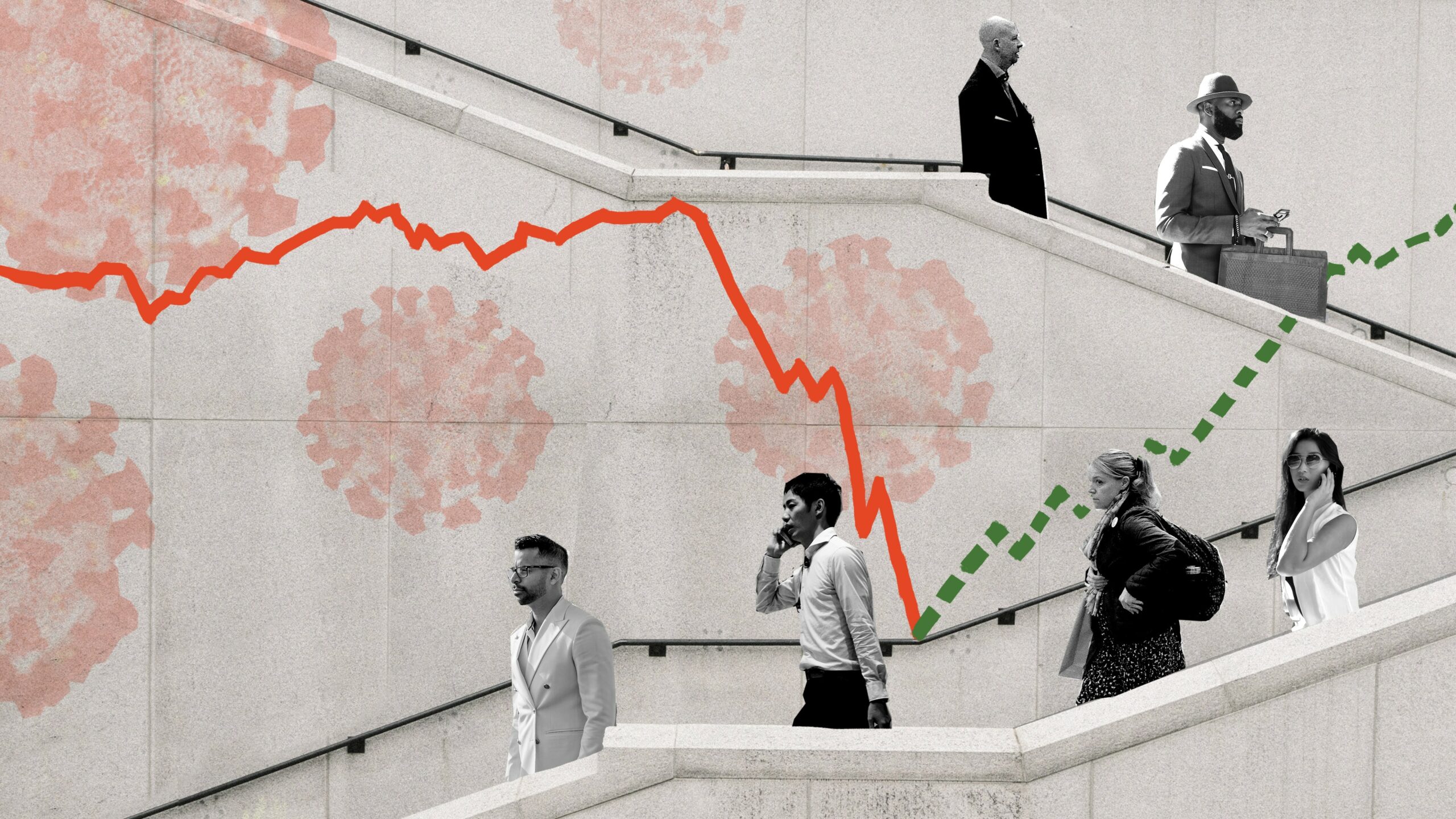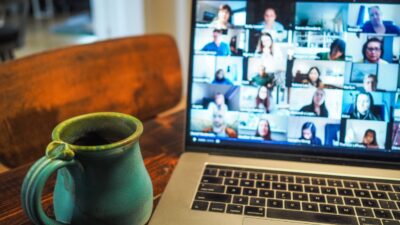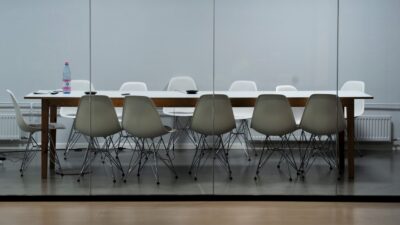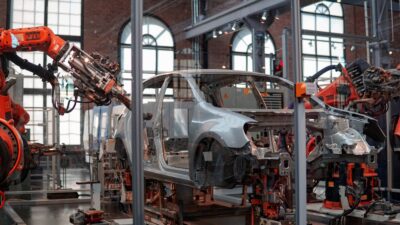Sandra Peter and Kai Riemer

Office changes on Corona Business Insights
How the office and office work might change in the wake of COVID-19.
As COVID-19 sets out to change the world forever, join Sandra Peter and Kai Riemer as they think about what’s to come in the future of business.
Shownotes
The end of the office as we know it
What will tomorrow’s workplace bring
How COVID-19 might change the office
Designers and architects discuss how home designs might change from the pandemic
Researchers at MIT on COVID-19 and remote work (an early look at US data)
The loneliness pandemic discussion on TFTW
This episode is part of a podcast series covering what COVID-19 will mean for the business world, where we look at the impact on the economy, businesses, industries, workers and society. This is part of our ongoing coverage of the impact of COVID-19 on the future of business.
Follow the show on Apple Podcasts, Spotify, Overcast, Google Podcasts, Pocket Casts or wherever you get your podcasts. You can follow Sydney Business Insights on Flipboard, LinkedIn, Twitter and WeChat to keep updated with our latest insights.
Send us your news ideas to sbi@sydney.edu.au.
Dr Sandra Peter is the Director of Sydney Executive Plus and Associate Professor at the University of Sydney Business School. Her research and practice focuses on engaging with the future in productive ways, and the impact of emerging technologies on business and society.
Kai Riemer is Professor of Information Technology and Organisation, and Director of Sydney Executive Plus at the University of Sydney Business School. Kai's research interest is in Disruptive Technologies, Enterprise Social Media, Virtual Work, Collaborative Technologies and the Philosophy of Technology.
Share
We believe in open and honest access to knowledge.
We use a Creative Commons Attribution NoDerivatives licence for our articles and podcasts, so you can republish them for free, online or in print.
Transcript
This transcript is the product of an artificial intelligence - human collaboration. Any mistakes are the human's fault. (Just saying. Accurately yours, AI)
Intro From the University of Sydney Business School, this is Sydney Business Insights.
Sandra And this is Corona Business Insights. I'm Sandra Peter.
Kai And I'm Kai Riemer.
Sandra And with everything that's happening, it's hard to understand what COVID-19 will mean for the business world. So we look at the economy, business, industry, government, workers, society, and try to unpack some of these effects.
Kai And today we talk about how COVID-19 might change the office and office work.
Sandra The pandemic has seen many of us across the world work from home, offices are already empty, many people are calling this the end of the office, as we know it. Many others are saying we will be returning to offices that will look somewhat the same as the ones we have now. And then there are people who say, well, office work has to change in the wake of this. So we thought we'd unpack this a little bit.
Kai So there's the proponents of digital work who say this is finally a wake-up call and we're moving to working digitally from just about anywhere, your home, coffee shops, whatever. So, this is a change that will forever either do away with the office or at least change what the office is for, and what the office looks like.
Sandra Let's start with the premise though that offices are probably here to stay. And they will probably change in the wake of this. And there are a number of different ways to think about this, and one might be to think about what types of changes we will see. And some of these changes might be quite visible changes in the way offices are laid out or occupied by people. But other ones might be invisible changes, things that happen to the background, to the infrastructure, to the way the office works behind the scenes.
Kai So you might walk into an office building and it might look very familiar, nothing much looks like it has changed. And yet there are subtle things that are now different. You walk into the elevator, there is no buttons, there is no need to press a button. Everything is now voice-controlled to reduce the surfaces on which people can exchange the virus.
Sandra There might be different ways in which the air in the building is filtered or circulated.
Kai Cleaning might happen much more often, surfaces are being sanitized more often, materials that are used on surfaces might be different, those on which the Coronavirus might not survive as long. So, these changes might not be immediately noticeable, but might be in the realm of the people designing or managing the buildings
Sandra And then there might be visible changes. Most of us remember the shift from cubicles to fully open plan offices, the size of the desks has also changed and the distance between people has also changed, and whilst we might still have the required two meters between two people sitting on the same side of a long bench or a long desk, we are quite often at the office facing someone sitting directly opposite from us. So, in those spaces, changes might come into play that will allow for more personal space and more distancing at work, meeting rooms that would previously accommodate 20 people might now only accommodate five six people to allow people the necessary distance.
Kai So open plan offices have often been designed for people to congregate, to have communal spaces, for people to be close to each other to huddle together in small work groups to keep noise down. Those things might change a lot as distance is more important, people might now face each other with their backs, rather than sitting face to face at desks to each other to reduce the spread of viruses. And also, people might be much more reluctant to hot desk with other people given that surfaces might hold the virus, or cleaning regimes might come in so the office might change markedly. We might even see the return of the one-person cubicle, and the abandonment of open plan offices in some companies where the space for doing this is available.
Sandra This is what's been termed de-densification, and it's really contrary to the trend we've seen in most organisations up until we had the pandemic where we found new methods of cramming more people into the same space. And we tried to deal with that by taking advantage of the times that they were in meetings or out of the office to justify the fact that we can actually put more people in a shared space than we could in individual spaces.
Kai So the de-densification might actually drive further the need to go to at least partial remote working, to not have everyone in the office at the same time, because in places like Sydney, real estate prices are fairly high, well we don't know whether this will stay the same after this pandemic. But given how much space is at a premium de-densification will have to lead to different ways of working and potentially office sharing on a day-by-day basis or on a certain roster.
Sandra But also the de-densification might occur as a direct result of the pandemic. Many businesses have laid people off, many businesses have gone bankrupt, so there are shared spaces that will naturally see fewer people come into work. And then there's also the working from home trend, which in certain developed countries does actually seem to be a trend that might stick around. And we've seen some initial studies coming out of the US where it is expected that about 25% of the employees will continue to work from home on multiple days a week. And this would compare to a rate of about 4% before the pandemic. Also, a new study from MIT has some preliminary findings that suggests that about 34% of people have switched from commuting to working from home, and that trend might continue after the pandemic.
Kai And so as businesses start to think about their office space, their gaze will widen. Office is not just what you have on premise now, it might not just be is in your buildings that you lease or own, but will extend into people's homes. So, there's now interesting conversations of what this might mean for the design of people's homes. Many homes for a long time have been designed with lots of open-plan living open-plan spaces, big rooms that flow into the outdoors, all of the kind of spaces that are not really conducive to working alone, or doing video conferences when more than one person is sharing the home at any one time. So it is quite possible that homes as they are being designed moving forward, Australia has a big culture of home improvement, that those projects will include smaller rooms, maybe soundproof, maybe optimized for having good camera angles and a non-cluttered background that will enable people to engage in video conferences in a much more professional environment than the kitchen tables and couches that we see on zoom so frequently at the moment.
Sandra So on the whole, what we're seeing is that some of these trends actually work against trends that we had in place before the pandemic, things like de-densification. Whereas previously we were trying to get more people into a shared space and get people closer and closer together in these spaces, even in social spaces, some other trends are actually working to accelerate trends that were in place before the pandemic started. So things like digital and remote work, trends that were already taking shape and that were already spreading in the business community before the pandemic are being accelerated by COVID-19.
Kai Which reminds me of this meme that's been circulating on social media: who has been driving the change towards digital work in your company?
a) the CEO b) the CTO, c) COVID-19.
Sandra And the right answer is obviously COVID-19 has made all of us go to digital or remote work. But we also need to recognise that even before the pandemic, many of these trends have played out differently in different cultures. In some Asian cultures being at work and being present is so deeply ingrained, that it's a much more difficult transition to remote work, something that is much more acceptable in an Anglo-Saxon work culture.
Kai So more collective, more socialising cultures, also in southern Europe, for example, where the breaks around work time are an opportunity to socialize where people actually congregate and having lunch together, which is different to many other Western countries where work is done in a more solitary fashion. You know, we've talked about the loneliness epidemic at work on The Future, This Week previously. So, countries with these different cultures remote work has never been and might likely even after the pandemic not happen to the extent that it might happen in places like the US, UK, Australia and more Anglo-Saxon countries.
Sandra And while it remains to be seen how these trends will eventually play out depending on how long the recovery will take from COVID-19...
Kai One thing is for sure, there will be more hand sanitizer in the workplace
Sandra And this is where we want to leave you. We'll be back soon.
Kai Until next time on Corona Business Insights.
Sandra Thanks for listening.
Kai Thanks for listening.
Outro From the University of Sydney Business School, this is Sydney Business Insights, the podcast that explores the future of business.
Close transcript













